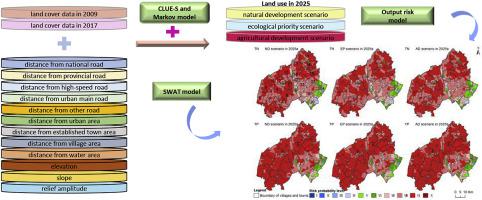Global Ecology and Conservation ( IF 4 ) Pub Date : 2020-06-03 , DOI: 10.1016/j.gecco.2020.e01144 Kang-Wen Zhu , Yu-Cheng Chen , Sheng Zhang , Zhi-Min Yang , Lei Huang , Lei Li , Bo Lei , Zhong-Bo Zhou , Hai-Ling Xiong , Xi-Xi Li , Yue-Chen Li , Shahidul Islam

|
The Fuling District is located in central Chongqing, China, and characterized by a high ecological status, a high ecological risk, a high agricultural proportion in economy, and a high agricultural non-point source pollution (AGNPS) risk, and represents the ecological security barrier of the Yangtze River and the Three Gorges Reservoir area. To analyze the output risk response of AGNPS under different land use scenarios in the future, we combined the advantages of various models and techniques such as the CLUE-S model, the Markov model, the SWAT model, and GIS technology and selected 12 driving factors for land use changes as well as one limiting factor of the ecological protection redline based on land use data of the Fuling District in 2009 and 2017, with the aim to perform an output risk probability evolution analysis of regional AGNPS. The three scenarios were natural development (ND), ecological priority (EP), and agricultural development (AD). The results were as follows: (1) from 2009 to 2017, land use change mainly consisted of the conversion from paddy field and dry land into construction land, accounting for 41.25% of the total area increase in construction land in 2017; (2) the simulation results of land use changes in Fuling District by combination of the CLUE-S model and the Markov model showed a high consistency; (3) from 2009 to 2017, the numbers of sub-basins where the TN risk level declined, remained unchanged, and increased were 36, 425, and 9, respectively, while in terms of the TP risk levels, the numbers were 16, 443, and 11, respectively; (4) under the three development scenarios of ND, EP, and AD, paddy field, dry land, forest land, and construction land were the main types of land use conversion; (5) the output risk levels of total nitrogen (TN) and total phosphorus (TP) both presented a declining trend at present and in the future, and the number of sub-basins where the risk level declined was highest under the EP scenario; (6) under the ND scenario, adjustments of ±5% or ±10% on the output coefficients of TN and TP could lead to an obvious response of the output risk probability level of sub-basins. Therefore, the sub-basins that were the most sensitive to changes in land use or output coefficients deserve considerable attention. Our results also indicate that the output risk levels of sub-basins and regional TN and TP could be reduced through land use optimization or fertilizer control, thereby minimizing regional AGNPS.


























 京公网安备 11010802027423号
京公网安备 11010802027423号